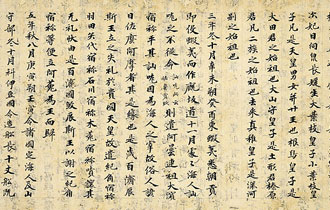Pages |
Theatrical Drumming—Hōgaku
While festival drumming was a major influence on the development of contemporary taiko performance, it was not the only stimulus for artistic development. The music performed in noh and kabuki theater, part of a larger genre called hōgaku, has also served as a source of inspiration for contemporary taiko artists. In the theater, taiko serve as accompaniment for songs and dancing as part of a larger ensemble, often featuring many of the same instruments that can be found in matsuri-bayashi as well as the tsuzumi (Figure 4). However, taiko are also occasionally featured on their own, such as in a kabuki piece called “Ichi-ban Daiko.” This work is performed on a large nagadō-daiko called an ō-daiko (literally, “large drum”) prior to the opening of a kabuki play, serving as notice that the play is about to start (Video 2).
The Rise of Kumidaiko: Oguchi Daihachi and Osuwa Daiko
Even as taiko have remained pervasive in Japanese society through their use in festival and theatrical music, the beginnings of the contemporary taiko movement stemmed as much from Western music as it did from these Japanese settings. Indeed, it was a jazz drummer who paved the way for the development of new compositional and performance techniques. Oguchi Daihachi, from Okaya, Nagano Prefecture, is credited as starting the contemporary taiko movement. Born in 1924, Oguchi took drum set lessons as a student at Waseda University in Tokyo before he was drafted into the army and sent to fight in China during the Second Sino-Japanese War during World War II. Following the war, Oguchi returned to Okaya and founded a bread company. At nights, he played drum set in light music groups in the region (light music was a general term for Western-influenced popular music developed in the post-war period).
Despite Oguchi’s drum set experience, however, he had very little experience playing taiko in festival settings, but his Western drumming experience would intersect with the world of Japanese festival drumming in the mid-1950s when he was asked by a relative to take a look at a fragment of a festival drumming score found in a local miso cellar. The score contained a drumming pattern for festival drumming that had not been in the region since the beginning of the century. Oguchi’s relative asked him to interpret the score and play the music at an upcoming festival, but Oguchi had no knowledge of either the notation or the music. As he later said, it was as if “a Western-style cook took in an order for sushi.” Nevertheless, he found the concept of reviving the music for a festival to be interesting and set out to learn how to play the music.
Oguchi managed to find an older resident of the town who had studied the festival drumming music with the person who wrote the score; additionally, he learned how to read the score from local priests. Thanks to these efforts, he was able to interpret the score and figure out how the music was supposed to sound: it was a series of several patterns played in alternation by two drummers on opposite sides of a single nagadō-daiko. Oguchi began to teach others how to play this music, with the intent of presenting it at the local Suwa Grand Shrine’s annual Ofune Matsuri. As they played, however, Oguchi found himself to be dissatisfied. The music did not appeal to his Western-influenced musical tastes, as he found it to be slow and repetitive.
Meanwhile, the drumming was meant to occur using just one drum, but he found it more interesting and fun to have all his friends play together on many drums.
Pages |











